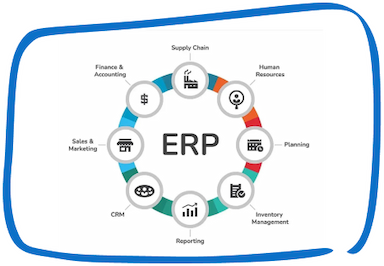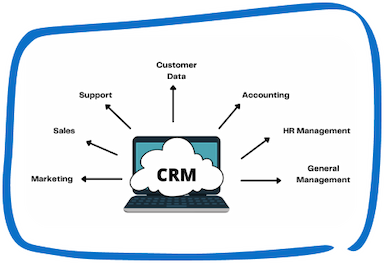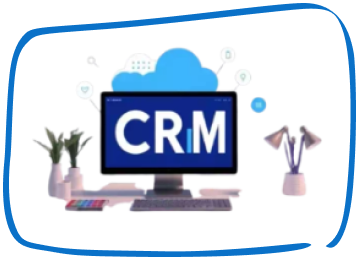Many businesses use enterprise resource planning (ERP) systems to manage their processes and enhance productivity. ERP systems are complex and need a major time and resource investment. To achieve a smooth transition to the new system and the realization of the advantages, there was a requirement for competent change management with ERP Software Implementation. In this blog post, we will examine a case study of a company that successfully implemented ERP software with effective change management.
Focusing on people and processes is essential for effective change management. A methodical, intentional approach that helps move individuals, groups, and organizations from their current state to the intended future state will be successful.
Case Study Background
Our client is a medium-sized manufacturing company that creates a range of sales items for clients around the globe. The business was having trouble controlling its supply chain, inventory, and production processes. To enhance their business processes and cut costs, they decided to invest in an ERP system.
Project management and change management approaches were rather immature. Due to the multiple mergers and acquisitions, each team had its leadership group and set of procedures that were semi-autonomous. As a result, every time the system was implemented in one of the divisions, everything was done differently.
The scattering of teams geographically among divisions made the challenge more difficult. This affected information exchange, training delivery, and adoption in addition to engagement and adoption.
They decided on our well-known ERP software solution – Elate ERP, that guaranteed to handle all of their operational problems.
The Implementation
A detailed analysis of the business’s processes and needs accompanied the implementation of the ERP software. Members of the project team came from a variety of departments, including production, sales, marketing, and finance. Elate ERP software and the team collaborated to customize the system to the requirements of the company.
For each employee who would be utilizing the system, our implementation team also ran a thorough training session. The training addressed the fundamentals of the ERP system, such as data entry, navigation, and report generation. Also, the team offered customized training to staff members who would be using the system regularly.
Change Management
Effective change management is responsible for our client’s company’s ERP implementation’s success. Four crucial areas were the emphasis of the change initiative: leadership support, employee engagement, communication, and role mapping.
Communication strategy
A big aspect of the change management initiative was communication. The Elate ERP team suggested the project team update all of the parties involved on the progress of the implementation. They discussed the advantages of the new technology and how it would enhance their work processes with the employees at regular meetings. The project team also employed a variety of communication tools to inform the employees of the potential changes, including emails, newsletters, and posters.
The team had to consider not only the messages being given but also the method by which they would be delivered. The team discovered that they could not rely on one source or method for communication due to the geographically distributed workforce. To make sure that all remote employees were informed of the implementation, the team had to get creative with the types of communications.
Employee Engagement
Another important factor of the change management approach was employee engagement. The project team began by involving the staff in the implementation procedure. To get feedback from the employees on their current work practices and how the new ERP system could enhance their work, they conducted surveys. The team also gave the employees a chance to test the system. They also suggested offering comments on its usability throughout the testing phase of the installation.
The group would then support both roles and distribute the information to the scattered units. As a result, there is now a greater connection between the teams and the company. The teams’ enhanced relationship ultimately overcame any residual resistance.
Leadership Support
The success of the ERP software implementation at our client’s company also absolutely depends on the support of the leadership. The senior management group gave the project team the tools and support they needed to put the new system into place. They showed their dedication to the project and informed the staff of the advantages of the new system. To make sure that the employees could operate the new system, the senior management team also supplied the required resources for training and development.
Role mapping
Implementing a Change Evaluation with a clear Role Mapping was one of the primary Change Management strategies. The purpose of the role mapping exercise was to give the team a better understanding of the condition of the business processes going forward, any associated tasks, and the resources that will be needed to complete those activities. This makes sure that no information about the process changes is overlooked. Furthermore, allocating resources to the roles helps with the planning and implementation of role-based training.
The change strategy or plan should include provisions for repeatedly performing the role mapping exercise. This will make it easier to accommodate any staff changes brought on by organizational changes or employee turnover in time for the going life.
Benefits achieved
The company at our client’s company gained many advantages from the implementation of the ERP system. The production, inventory, and supply chain procedures of the business were made more precise and effective by the new system. Additionally, the technology offered real-time data and analytics that helped the corporation make smart business decisions. Also, the new technology assisted the business in cost-cutting and customer service improvements.
Conclusion
ERP implementation can be a challenging process, but with the right change management, the shift can go smoothly and achieve advantages. The case study of our client’s business serves as an example of an ERP tool installation. It was successful, emphasizing the value of effective communication, employee engagement, leadership support, and role mapping. By concentrating on these important areas, the implementation team achieved a successful ERP implementation that enhanced business processes and reduce expenses.
Speak with Our Team!
4.9 Stars
1k+ reviews on






